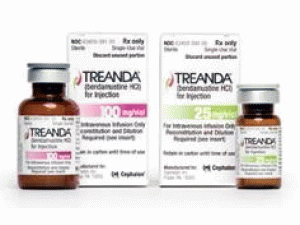盐酸苯达莫司汀, 盐酸苯达莫司汀冻干粉注射剂Treanda Injection 100mg(Bendamustine )
 药店国别:无
产地国家:美国
处方药:是
所属类别: 100毫克/瓶
包装规格: 100毫克/瓶
计价单位:瓶
生产厂家中文参考译名:无
生产厂家英文名:Cephalon
原产地英文商品名:Treanda Injection 100mg/vial
原产地英文药品名:bendamustine HCl
中文参考商品译名:Treanda注射剂 100毫克/瓶
中文参考药品译名:苯达莫司汀
曾用名:无
药店国别:无
产地国家:美国
处方药:是
所属类别: 100毫克/瓶
包装规格: 100毫克/瓶
计价单位:瓶
生产厂家中文参考译名:无
生产厂家英文名:Cephalon
原产地英文商品名:Treanda Injection 100mg/vial
原产地英文药品名:bendamustine HCl
中文参考商品译名:Treanda注射剂 100毫克/瓶
中文参考药品译名:苯达莫司汀
曾用名:无
简介
美国FDA于2008年3月21日批准Cephalon公司的盐酸苯达莫司汀(bendamustine,Treanda)用于慢性淋巴细胞性白血病(CLL)。CLL是1种恶性的淋巴细胞克隆性增殖性疾病,多见于老年人,平均发病年龄70岁,且男性多于女性。 据美国癌症学会预计,2008年美国将有15000例CLL新发病例。分析师预计本品年销售峰值在3~5亿美元。此外,本品另一适应证-非霍奇金淋巴瘤目前正等待FDA批准。 盐酸苯达莫司汀(Bendamustine Hydrochloride)是一种双功能基烷化剂,具有抗肿瘤和杀细胞作用。本品的抗肿瘤和杀细胞作用主要归功于DNA单链和双联通过烷化作用交联,这打乱了DNA的功能和DNA的合成,也会使DNA和蛋白之间,以及蛋白和蛋白之间产生交联,从而发挥抗肿瘤作用。 本品作为单用或联合化疗,对何杰金氏淋巴瘤和非何杰金氏淋巴瘤的治疗反应率分别为61%~97%和41%~48%。主要应用于单独或与其它抗肿瘤药物联合用药来治疗下列恶性肿瘤:何杰金病;非何杰金淋巴瘤;浆细胞瘤(多发性骨髓瘤);慢性淋巴细胞白血病(CLL);乳腺癌。 本品用于何杰金病、非何杰金淋巴瘤、多发性骨髓瘤、CLL和乳腺癌。 其剂量血癌为50~60mg/m²/d,3~5天或每3~4周为100~120mg/m²;实体瘤每4周为120~150mg/m²,每日1次,30~60min静脉滴注。盐酸苯达莫司汀作为单用或联合化疗,对何杰金病和非何杰金淋巴瘤的治疗反应率分别为61%~97%和41%~48 %。 对多发性骨髓瘤病人,苯达莫司汀/泼尼松治疗的完全反应率较高(32%),美法仑/泼尼松疗法反应更持久。在环磷酰胺、长春新碱、泼尼松治疗方案中,苯达莫司汀取代环磷酰胺,对发展中低度毒性非何杰金淋巴瘤有相似的反应率。 在环磷酰胺、甲氨蝶呤、氟尿嘧啶治疗方案中,苯达莫司汀取代环磷酰胺,使转移性乳腺癌病人的缓解期从6.2个月延长至15.2个月。盐酸苯达莫司汀作为新一代抗癌药物,对多种癌症具有明显的治疗作用。 临床应用表明,本品单独治疗或联合用药治疗非何杰金淋巴瘤、多发性骨髓瘤、CLL和乳腺癌等,疗效确切,明显降低复发率与死亡率,而且不良反应小,安全性好。 **盐酸苯达莫司汀(Bendamustine Hydrochloride)化学名为4-[5-[双(2-氯乙基)氨基]-1-甲基苯并咪唑-2-基]丁酸盐酸盐。早在上世纪60年代,盐酸苯达莫司汀即由前东德研制而成,并被广泛应用,但直到冷战结束,该药才在欧洲进行了多项单药或联合其他药物治疗多种血液系统恶性肿瘤或实体瘤的临床研究,疗效非常可观。到目前为止,盐酸苯达莫司汀单药或联合治疗方案已被欧美临床指南指定为多种血液系统恶性肿瘤的一线或二线治疗选择。 2003年,盐酸苯达莫司汀在德国上市,商品名为“Ribomustin”。在美国上市的盐酸苯达莫司汀商品名为“Treanda”,由Cephalon公司提出上市申请,并于去年通过优先审批程序获得FDA批准适应症2008年3月,FDA首先批准盐酸苯达莫司汀用于治疗慢性淋巴细胞性白血病(CLL)。 同年10月,FDA又批准了该药的第2个适应证,即在利妥昔单抗(rituximab,美罗华)或含利妥昔单抗方案治疗过程中,或者治疗6个月内,病情仍然进展的惰性B细胞非霍奇金淋巴瘤(NHL)患者。药理及药代动力学盐酸苯达莫司汀的确切作用机制尚不十分清楚,但已知该药是携带一个嘌呤样苯并咪唑环的氮芥衍生物,兼具烷化剂和嘌呤类似物(抗代谢药)的双重作用机制。盐酸苯达莫司汀能通过几种不同途径导致细胞死亡,而且对静止期和分裂期细胞均有效。 盐酸苯达莫司汀血浆蛋白结合率为94%~96%,数据显示该药一般不会与其他高蛋白结合药物相互置换。盐酸苯达莫司汀平均稳态分布容积约为25L,其全血/血浆浓度比为0.84~0.86。盐酸苯达莫司汀主要通过水解反应进行代谢,同时形成细胞毒性较低的代谢产物。 该药经CYP1A2代谢途径可产生M3和M4两种活性代谢产物,但两者血浆浓度只分别相当于母体化合物的1/10和1/100,因此,可以推测苯达莫司汀的细胞毒性作用主要来自于其本身,而非其代谢物。 禁忌症:对盐酸苯达莫司汀及甘露醇过敏者禁用。 药物相互作用 与CYP1A2抑制剂(如氟伏沙明,环丙沙星等)合用时,有可能会升高苯达莫司汀血浓度,并使其代谢物M3和M4浓度降低;与CYP1A2诱导剂(如奥美拉唑,抽烟等)合用时,有可能会降低苯达莫司汀血浓度,并使其代谢物M3和M4浓度升高。 不良反应 苯达莫司汀常见不良反应包括恶心、呕吐、腹泻、疲乏、虚弱、皮疹、搔痒、一些感染症状和体征(如持续咽喉疼痛、发热和寒战)、容易碰伤/出血以及口腔溃疡等;严重不良反应可能还有骨髓抑制、肿瘤溶解综合征等。苯达莫司汀可能引起轻微或严重过敏反应,患者在给药过程中或给药后初期可能出现皮疹、面部肿胀、呼吸困难等过敏症状。 苯达莫司汀可能对胎儿造成影响,因此,女性治疗过程中及治疗后3个月内,应采取适当避孕措施及停止哺乳。 剂量及用药 苯达莫司汀冻干粉针呈白色至灰白色,规格为100mg/支。该药储存温度不应超过30℃,避光保存,使用前临时配制。 配药说明: 该药每100mg须先溶于20ml无菌注射用水,充分振摇直到完全溶解成澄清、无色或淡黄色溶液,溶解时间一般不超过5分钟,溶解后浓度为5mg/ml。在溶解后30分钟之内,根据需要抽取适量苯达莫司汀水溶液,转移至500ml氯化钠注射液(0.9%)或葡萄糖氯化钠注射液(2.5%/0.45%)中,并确保苯达莫司汀在注射液中的最终浓度在0.2~0.6mg/ml之间。 配制好的注射液可在2~8℃冷藏保存24小时,或在室温及自然光下保存3小时。苯达莫司汀治疗CLL时,以28天为一个治疗周期,一般需要6个治疗周期。在每个治疗周期的第一天和第二天给药,推荐剂量为100mg/m2。该药经静脉滴注给药,每次给药时间不应少于30分钟。 苯达莫司汀治疗NHL时,以21天为一个治疗周期,一般需要8个治疗周期。在每个治疗周期的第一天和第二天给药,推荐剂量为120mg/m2。每次给药时间不应少于60分钟。 患者咨询用药前应告知主诊医生有关过敏史、详细的用药史及其他伴发疾病,特别是血液/骨髓病、肾脏病、肝病、感染疾病等,同时应与医生详细讨论服药的风险及受益情况,避免与其他可能产生不良相互作用的药物合用。该药可能使现有感染加重,因此,在未征得医生同意前,患者不要自行进行疫苗接种;同时应避免与近期口服过脊髓灰质炎疫苗或通过鼻吸入给予流感疫苗的人群,又或者是其他传染病(如水痘、流感)患者接触。英文版说明
Treanda (bendamustine hydrochloride)Company: CephalonApproval Status: Approved October 2008Treatment for: Chronic lymphocytic leukemia and B-cell non-Hodgkin’s lymphomaAreas: Cancer & OncologyGeneral InformationTreanda is a rationally designed purine analog and alkylator hybrid. It damages the DNA in cancer cells, which leads to the normal path of cell death (apoptosis). It also stops cancer cells from dividing to create new cancer cells.Treanda is specifically indicated for: 1) the treatment of chronic lymphocytic leukemia where efficacy relative to first line therapies other than chlorambucil has not been established, and 2) indolent B-cell non-Hodgkin’s lymphoma that has progressed during or within six months of treatment with rituximab or a rituximab-containing regimen.Treanda is supplied as a powder in a 100 mg vial to be reconstituted with sterile water for intravenous administration.The recommended initial dose of the drug for the treatment of non-Hodgkin's lymphoma is 120 mg/m2 administered intravenously over 60 minutes on Days 1 and 2 of a 21-day cycle, up to 8 cycles. Treanda administration should be delayed in the event of a Grade 4 hematologic toxicity or clinically significant > Grade 2 non-hematologic toxicity.Dose modifications for hematologic toxicity: reduce the dose to 90 mg/m2 on Days 1 and 2 of each cycle. If Grade 4 toxicity recurs, reduce the dose to 60 mg/m2 on Days 1 and 2 of each cycle.Dose modifications for non-hematologic toxicity: reduce the dose to 90 mg/m2 on Days 1 and 2 of each cycle. If Grade 3 or greater toxicity recurs, reduce the dose to 60 mg/m2 on Days 1 and 2 of each cycle.The recommended initial dose of the drug for the treatment of chronic lymphocytic leukemia is 100 mg/m2 administered intravenously over 30 minutes on Days 1 and 2 of a 28-day cycle, up to 6 cycles. Treanda administration should be delayed in the event of Grade 4 hematologic toxicity or clinically significant >Grade 2 non-hematologic toxicity.Dose modifications for hematologic toxicity: reduce the dose to 50 mg/m2 on Days 1 and 2 of each cycle; if Grade 3 or greater toxicity recurs, reduce the dose to 25 mg/m2 on Days 1 and 2 of each cycle.Dose modifications for non-hematologic toxicity: reduce the dose to 50 mg/m2 on Days 1 and 2 of each cycle.Clinical ResultsFDA ApprovalFDA approval for Treanda for the treatment of chronic lymphocytic leukemia was based on the results of an open-label, randomized, controlled multicenter trial in 301 previously-untreated patients with Binet Stage B or C (Rai Stages I - IV) CLL requiring treatment. The subjects received either Treanda at 100 mg/m2, administered intravenously over a period of 30 minutes on Days 1 and 2 or chlorambucil at 0.8 mg/kg administered orally on Days 1 and 15 of each 28-day cycle. Efficacy endpoints were objective response rate and progression-free survival. The overall response rate was 59% in the Treanda arm compared to 26% in the chlorambucil arm (p<0.0001). The median progression free survival was 18 months in the Treanda arm versus 6 months in the chlorambucil arm (p<0.0001).FDA approval for Treanda for the treatment of non-Hodgkin's lymphoma was based on the results of a single arm study of 100 subjects with indolent B-cell NHL that had progressed during or within six months of treatment with rituximab or a rituximab-containing regimen. All subjects received Treanda intravenously at a dose of 120 mg/m2, on Days 1 and 2 of a 21-day treatment cycle. They were treated for up to 8 cycles. Overall response rate was seen in 74 of the subjects (64.3%). The median duration of response was 9.2 months.Side EffectsAdverse events associated with the use of Treanda for chronic lymphocytic leukemia may include, but are not limited to, the following:pyrexianauseavomitingastheniafatiguemalaiseweaknessdry mouthsomnolencecoughconstipationheadachemucosal inflammationstomatitisAdverse events associated with the use of Treanda for the treatment of non-Hodgkin's lymphoma may include, but are not limited to, the following:nauseafatiguevomitingdiarrheapyrexiafatiguefebrile neutropeniapneumoniahypokalemiadehydration.Mechanism of ActionTreanda contains bendamustine hydrochloride, an alkylating drug. Bendamustine is a bifunctional mechlorethamine derivative containing a purine-like benzimidazole ring. Mechlorethamine and its derivatives form electrophilic alkyl groups. These groups form covalent bonds with electron-rich nucleophilic moieties, resulting in interstrand DNA crosslinks. The bifunctional covalent linkage can lead to cell death via several pathways. Bendamustine is active against both quiescent and dividing cells. However, the exact mechanism of action of bendamustine remains unknown.用药温馨提示:当您服用此药物时,需定期接受医疗专业人士的检查,以便随时针对其药效、副作用等情况进行监测。本网站所包含的信息旨在为患者提供帮助,不能代替医学建议和治疗。
药品价格查询,专业药品查询网站,药品说明书查询,药品比价 » 盐酸苯达莫司汀, 盐酸苯达莫司汀冻干粉注射剂Treanda Injection 100mg(Bendamustine )
药品价格查询,专业药品查询网站,药品说明书查询,药品比价 » 盐酸苯达莫司汀, 盐酸苯达莫司汀冻干粉注射剂Treanda Injection 100mg(Bendamustine )


